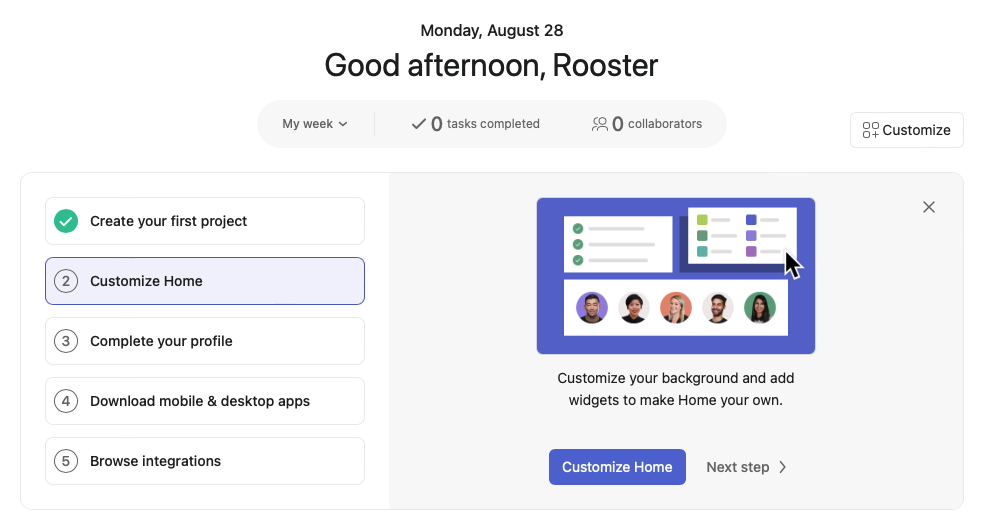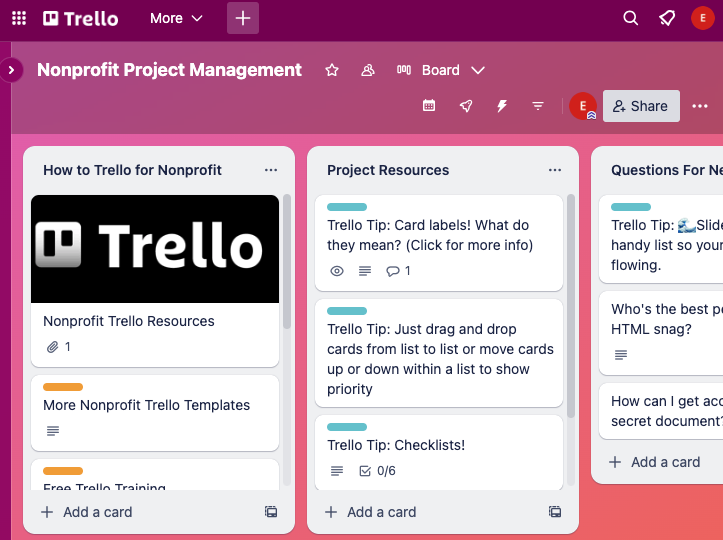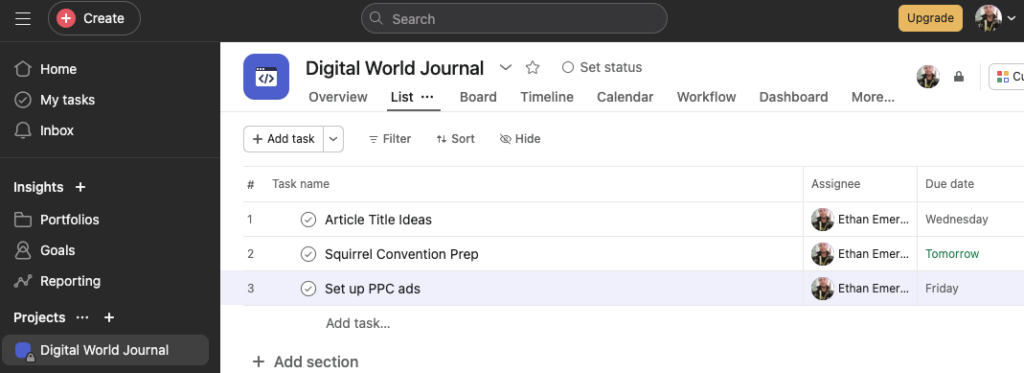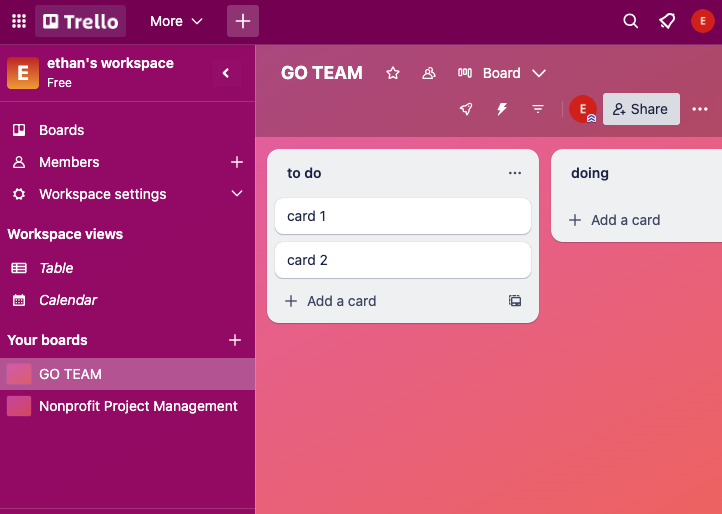Target market: Project managers who aren’t happy with Trello and want a replacement that will support better collaboration and workflows.
Note: I am not affiliated with Asana; I just love the application and enjoy the science behind productivity.
Asana: The Trello Alternative That Simplifies
Collaboration and Streamlines Productivity
So Projects Get Delivered Faster
Trello gets plenty of praise, but when it comes to the nitty-gritty of project management, some of Trello’s features may actually be killing your team’s productivity.
A good task management system will support productive workflows, minimize distractions, and be user-friendly without a steep learning curve. Asana meets all of these requirements, while Trello falls short.
If you’re considering migrating away from Trello, you’re about to learn why Asana is the gold standard in productivity tools.
Do any of these sound familiar?
- Important deadlines are being missed.
- Dependencies fall through the cracks.
- Your current project management app is cumbersome.
- Task due dates are continually shifted around.
- Team members aren’t clear on expectations.
- Your clients lose patience over late deliverables.
If you experience any of the above, Asana might be just what you’re looking for.
Effective project management
begins with Asana
Meet the world’s most versatile,
easy project management solution.
Asana is a powerful, easy-to-use, affordable project management solution used by millions of organizations worldwide to ensure satisfied end users and clients.
If you want to simplify your project management process and increase efficiency across all your teams and projects, you need Asana. Compared to Trello, it’s the gold standard in project management, collaboration, and productivity.
Advantages of using Asana:
- A free account accommodates up to 15 team members and has all the features small companies need to be successful.
- Uses clear, standard project management lingo (projects, tasks, app integrations).
- Smooth and intuitive UX/UI.
- Paid plans show task dependencies.
- Sub-tasks allow you to assign one project to multiple people.
- Users can create private tasks to better control their workflow needs.
- Dynamic, granular reporting.
- More than 100 integrations.
- Naturally commands team member buy-in.
Disadvantages of using Asana:
- Most medium and large businesses need to upgrade to a paid plan.
- No native time tracking tool.
- Advanced features take time to learn.
Advantages of using Trello:
- The free plan comes with unlimited users.
- Drag-and-drop interface.
- Supports collaboration.
Disadvantages of using Trello:
- Uses custom lingo (boards, cards, Power-Ups).
- Free plan allows only ten boards (projects).
- Projects (boards) are arranged in visual tiles at the bottom of the page rather than a simple list in a side bar.
- No task dependencies, even with a paid plan.
- Distracting aesthetics.
- Complex UX/UI.
- Some “Power-Ups” make Trello feel more like a game than project management.
- Requires deleting or renaming demo content to use a template.
- Requires a paid plan to access list and calendar views.
Now let’s dive into the details!
1. A simple setup has teams running in minutes
Whether you’re new to project management applications or you’re migrating to a different solution, a speedy setup means your team can start working immediately.
Asana
Asana immediately gets down to business and helps you create a fluff-free customized workspace.
The automated setup prompts you to create your first project and tasks using familiar language and you’re ready to start assigning tasks in minutes.

Trello
Although setup is fast, it’s convoluted. The setup process uses the term “board” in place of “project,” and “card” in place of “task.”
You’re then prompted to create three cards using sample categories of “to do,” “doing,” and “done.” This seems helpful, but this structure might not be productive for your team. Do you really need to manually move tasks into a section to indicate they’re in progress? From a productivity standpoint, this seems unnecessary.
Once you get into your workspace, you’ll have the option to load a template. At first glance, having access to hundreds of templates might sound like a great idea, but templates are for websites, not project management.
Templates add a layer of unnecessary complexity to project management.

Applying a template creates a new board and adds a handful of cards with pre-loaded demo content you have to either edit, rearrange, rename, or delete. That’s a lot of extra work just to start managing a project. It’s faster to build only the cards you need from scratch. You should never have to spend time deleting unnecessary elements just to get started.
2. Aesthetics that minimize distraction increase productivity
Aesthetics matter. A visually-distracting workspace burns more brain power, leaving team members with less focus and energy for completing assignments.
Employees are already dealing with distractions that waste 40-60% of their time. And it takes around 23 minutes and 15 seconds to get back on track. The last thing you need is a distracting task management system.
Asana
Asana’s aesthetics are completely professional. Just like great typography, you want the aesthetics of your workspace to go unnoticed. Asana’s color scheme automatically supports productivity because it doesn’t stand out.
The default colors are a high contrast black or dark gray with light text for the side bar, and the main work area has plenty of white space. It’s simple and blends into the background, making it easier to concentrate on work.

Trello
Trello embodies an atmosphere of distraction and feels too casual.
The first time you access your account, the background is a bright, pink and purple gradient. You can change the color, but your choices are limited to nine pre-defined bold colors, several graphical designs, or you can upload your own image.
There is no color picker, which makes using a lighter, neutral, non-distracting background impossible unless you make your own background image in Photoshop. You shouldn’t have to go that far just to get a distraction-free workspace.

3. Navigation (or UX/UI)
Navigation is more than just a website’s main menu – it’s how users get around by clicking links anywhere on a page. In this sense, navigation also encompasses UX/UI, which stands for User Experience and User Interface.
Navigation should be intuitive and simple with a limited number of clicks required to edit content. Complex navigation decreases productivity and hinders workflow. This is true even when teams enjoy using an application.
Asana
Asana’s navigation has been refined to perfection. It’s clear this application was built by UX/UI experts. Navigation is limited to what’s important, icons are clear, and menus with multiple options have been condensed.
When you look at a workspace in Asana, you’re looking at a clean, distraction-free, user-friendly design. It’s immediately clear where you need to click to access every aspect of your project, from tasks and categories to notifications and even profile settings.
There is nothing complex about Asana. There are no cryptic icons or unnecessary features to figure out. The learning curve is easy and most teams can start using it within five minutes of creating a project.
Best of all, you never have to click an ‘edit’ button – just click the text directly and it becomes editable. With Asana, teams save thousands of clicks every day.
Trello
Trello falls short in the UX/UI department. There are too many cryptic icons, numerous links, and menus to click. It’s not intuitive; the learning curve for figuring it all out is pretty steep.
In addition to a complicated UX/UI, Trello’s ‘board’ view makes a workspace look cluttered. Unless you upgrade to a paid version, you can’t use the “table” view that condenses cards (tasks) into neat rows with clearly visible deadlines.
Even More Reasons to Choose Asana
App integrations expand your team’s efficiency
The more platforms your team has to use, the less productive they’ll be. With more than 100 apps to choose from, Asana integrations will keep your team working on one platform while proving access to the core applications they need.
Asana integrations include:
- Box
- Vimeo
- Google Docs
- Gmail
- Salesforce
- Slack
- Azure Active Directory
- Microsoft Teams
- Zapier
- Zendesk
- And more
Fortune 500 companies use Asana
When you adopt Asana in your organization, you’ll have access to the same world-class features that fortune 500 companies use to drive their success. Teams from Adobe, Airbnb, Deloitte, Google, Amazon, Spotify, PayPal, and even Slack all reach their goals with Asana.
Automatically get team member buy-in
When you introduce Asana to your team, their workflow will be so smooth you won’t need to convince them to use it. They’ll naturally accept it and before long, it will be as if they’ve never used anything else.
Customizable workspaces
People are most productive when they have control over the aesthetics and organization of their workspace. Asana allows each team member to display projects and tasks the way they prefer, whether it’s a list, board, or timeline.
Say goodbye to complex user interfaces
A project management tool with complex navigation complicates client projects. Task management should be easy. When your team uses Asana, they’ll find the learning curve to be short, simple, and pleasant.
It shouldn’t take more than one click for users to view their tasks and deadlines. When you use Asana, it won’t take any clicks – logged in users will immediately see an overview of upcoming tasks on their dashboard.
Put an end to missed deadlines
Asana can’t magically transform lazy team members into high achievers, but missed deadlines are often the result of something else entirely. Thankfully, Asana can support you in changing this dynamic.
Most projects fall behind schedule for three reasons:
- Unrealistic deadlines (or no deadlines)
- Unclear expectations
- Invisible dependencies
- Chaotic workflows
When you use Asana, tasks are more than just to-do lists. They become dynamic conversations that allow you to clearly define expectations and have a dialogue with team members to clarify their questions, concerns, and misunderstandings.
It’s a drag when someone procrastinates because they don’t know other people are waiting on them to move forward with their part of the project. To support task transparency, Asana makes dependencies clearly visible to all project members.
Put an end to the chaos of missed deadlines, disorganized workflows, and dependency bottlenecks. Start streamlining workflows so your team knows exactly what to do and when to deliver results.
When you streamline your team’s workflow, your project automatically becomes easier to manage. You might even start to see team members completing tasks ahead of schedule.
What users are saying about Asana
“I never realized how much time I wasted clicking through categories and menus in my old task management application. With Asana, I don’t even need to click an edit button to update my tasks or comments – the text becomes immediately editable with one click.”
– Jason H., New York
“Before I moved my team to Asana, we were using old school handwritten task lists. I can’t believe I didn’t move out of the stone age sooner. Now our company is turning a 6-figure profit and our customers are leaving us amazing reviews on Google.”
– Sally P., Indiana
“I’ve been a project manager years and it’s always been a challenge to get a budget for good task management software approved. Asana is so affordable my request was approved right away, and we’ve had a nearly 100% employee adoption rate.”
– Dave G., California
Who should use Asana?
- Teams with specialized projects that require dependencies
- Teams with complex workflows
- Small teams <15 people who want to keep task management free
- Medium to large teams
- Teams who follow the Agile methodology
Streamline Communication, Improve Workflows,
And Simplify Task Management With Asana
Asana is the ideal solution when profitability
depends on delivering projects on time.
Flow better with Asana
If you’re ready to experience the amazing power of Asana to transform your company’s workflow and become unstoppable, sign up for a 30-day free trial today and you’ll be one step closer to running a more efficient, profitable business.
